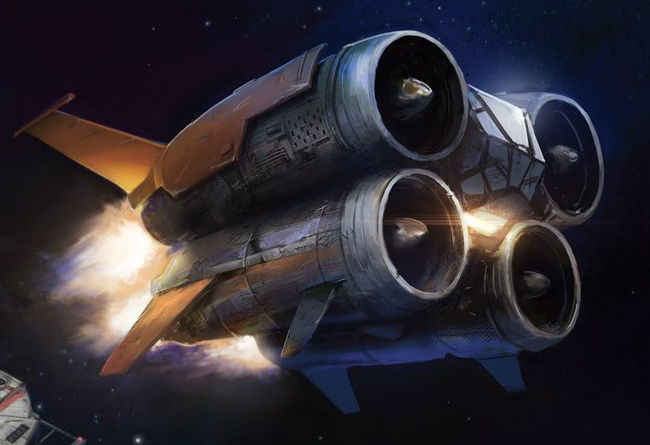TUG-b13
Craft: TUG-b13
Type: Subpro Quadrijet transfer spacetug
Scale: Starfighter
Length: 7.98 meters
Skill: Space Transports: Quadjet
Crew: 1
Cargo Capacity: 1 Metric Ton
Consumables: 1 month
Cost: 55,000 (new) 18,000 (used)
Hyperdrive: No
Nav Computer: No
Maneuverability: 1D
Space: 4
Atmosphere: 222,800kph
Hull: 4D
Shields: None
Sensors:
Passive: 18/0D
Scan: 36/1D
Search: 54/2D
Focus: 2/3D
Background: The TUG-b13, also known as the quadrijet transfer spacetug and more commonly known simply as the quadjumper, was a type of spacetug manufactured by Subpro Corporation. The quadrijet transfer spacetug was a model of spacetug manufactured by Subpro Corporation for use in orbital transfer yards. The vessels used magnetic clamps to attach themselves to the undersides of cargo containers and then quickly move them around within the yards using their four large thrusters. This was a vital service given that every second spent moving cargo containers meant credits lost for a transfer yard boss, and most bulk freighter captains lacked the equipment to move their cargo across the final few kilometers from their vessels to the hands of their customers. The vessel measured 7.98 meters in length and required a single pilot to operate, with room for two passengers. It could be entered and exited through a rear hatch located between the four thrusters at the back of the ship, which was accessible by a retractable ladder stored beneath the cabin. The hatch would seal during flight using a hatch locking claw.
The quadjumper’s four cylindrical thrusters had engine intakes located at the front of the spacetug, with electrostatic baffle vanes that kept out dust. Behind these were a series of compressor blades, which made up the turbine engines used by the craft in atmospheric flight. These connected to an central thrust nozzle located at the rear of the engine. The thruster’s ignition chamber and fuel atomizer were then located behind the blades, and at the rear of the thruster were the ion drives used for space flight, which kicked in once a series of thrust bypass doors opened as the craft left atmosphere. These connected to an outer thrust ring running around the turbine engine’s central nozzle. Coolant pumps and lines, plus the vessel’s power cells were also located at the rear, packed within the engine’s casing beside the ion engines. The vehicle lacked any armament, but could be easily modified with additions to the dorsal attachment points including weaponry, sensor packages or external fuel tanks. Special modifications were needed to increase cargo or fuel capacity.
The upper two thrusters were partially covered by red heat exchanger plates, while all four were equipped with repulsor stabilizer vanes. The quadjumper’s hydraulic landing gear was built on the craft’s base, emerging between the two lowest thrusters. Above the vessel’s cockpit, the spacetug had a tow cable housed underneath the rear hatch at the back of the ship. The bow cockpit itself was designed to give the single pilot maximum visibility and so consisted of almost entirely transparisteel viewports. Two passenger seats were located behind the pilot’s seats, and could be folded away in order to allow access between the cabin and the cockpit. The cabin itself took up the central space between the four thrusters and was located above the vehicle’s fuel tank. It included at least one crew bunk built into the side walls and had hatches at either end leading to the cockpit and exiting the ship. A retractable cargo crane was hidden directly above the cabin on the roof of the ship and could be used to guide a refueling hose that was housed with it. The magnetic clamps used to attach the vessel to freight containers were located above the cockpit of the tug.




